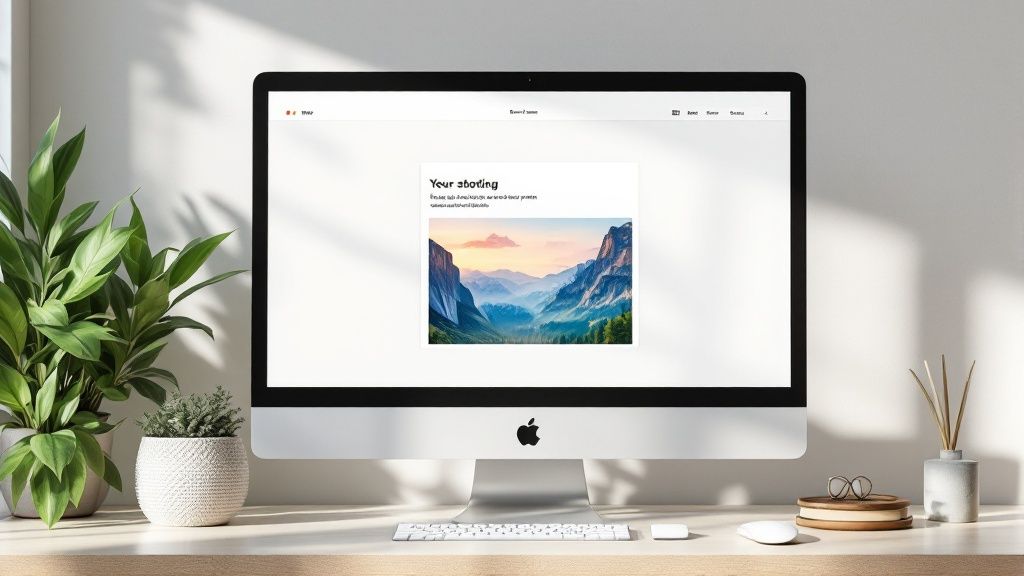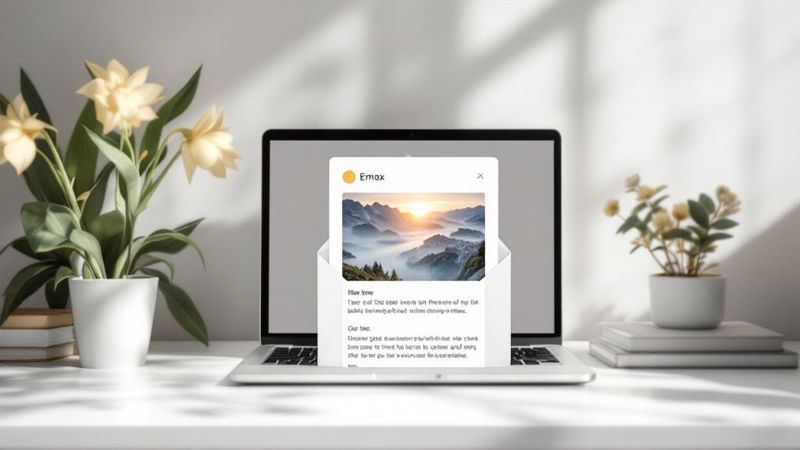Why Images on Email Make or Break Marketing Success
In today's overflowing inboxes, a strategically placed image can be the deciding factor between an email being opened and instantly deleted. Crafting compelling copy is no longer enough; you need to grab attention immediately. Visuals are the key to achieving this. Think about your own inbox – aren't you more drawn to emails with captivating graphics?
This isn't just about aesthetics. There's a real science behind the effectiveness of images in email. Our brains process visuals much faster than text. We can process about 36,000 visual messages per hour, making visuals essential for effective email marketing. Emails with images also boast a 4.5% higher click-through rate (CTR) than text-based emails. Many marketers aim for a visual balance, incorporating images that make up 20% to 50% of the email's content to maximize engagement without triggering spam filters. Learn more about image impact in emails: Find more detailed statistics here.
The Psychology of Visual Engagement
Images connect with the emotional centers of our brains, creating a deeper connection with your message. A picture of a smiling family, for instance, can evoke warmth and trust, while a vibrant product image can spark excitement and desire. These emotional responses drive engagement and conversions. This means using relevant, high-quality images isn't just a design choice; it's a strategic necessity.

Transforming Campaigns with Visual Storytelling
Strategic visuals can elevate an average email campaign into a high-performing asset. Think about how images can tell a story, showcasing your product or service's benefits in a way that resonates with your target audience. Visual information cuts through the noise and makes your message memorable. This boosts brand recognition and recall, strengthening your brand's presence in the customer's mind.
Ultimately, images in email are more than just decoration; they are powerful communication and persuasion tools. By understanding the psychology of visual processing and implementing effective visual strategies, you can significantly improve your email marketing results and build stronger connections with your audience.
Proven Best Practices for Images on Email That Convert

We know why images are important for email marketing. Now, let's dive into how to use them effectively. It's more than just adding pretty pictures. It's about a strategic approach that boosts conversions. For a solid foundation, consider checking out some established Email Marketing Best Practices.
Optimizing Image Dimensions and File Formats
First things first: get the technical details right. Oversized images slow down load times, which can frustrate recipients and even land your email in spam. Tiny images, on the other hand, look pixelated and unprofessional. The key is finding the right balance of dimensions and file format.
- Dimensions: A maximum width of 600-800 pixels works well for most email clients. This ensures proper display without horizontal scrolling.
- File Format: JPEGs are usually the best choice for photos, providing good quality without huge file sizes. PNGs, with their transparency support, are perfect for graphics with sharp lines and text. Steer clear of TIFFs and other large formats.
Strategic Image Placement and Visual Hierarchy
Image placement matters just as much as the image itself. Think about how people naturally scan content. Use your images strategically to guide their attention. A hero image at the top can grab interest, while smaller images throughout the email break up text and illustrate points.
Placing a call-to-action button right below a related image can dramatically improve click-through rates. This creates a smooth visual flow, leading the recipient to the desired action.
Alt Text and Accessibility
Don't overlook alt text, the descriptive text that shows up if an image doesn't load. It's not just for accessibility. Alt text helps spam filters understand your email's content. Keep it clear, concise, and descriptive of the image, reinforcing your message. For a deeper dive, check out this helpful guide on How to master email marketing images.
Real-World Examples and Results
Many brands have seen real improvements by following these best practices. One company boosted their click-through rates by 20% simply by optimizing image dimensions and adding strong alt text. Another reduced bounce rates by 15% by improving image load times. Even small changes can make a big difference.
To help you get started, here’s a handy guide to follow:
Recommended Image Specifications for Email: A comprehensive guide to optimal image specifications for email marketing campaigns
| Specification | Recommendation | Reason |
|---|---|---|
| Dimensions | 600-800 pixels wide | Ensures proper display on most email clients without horizontal scrolling |
| File Format | JPEG for photos, PNG for graphics | JPEG offers a good balance between quality and file size, while PNG supports transparency for sharp lines and text |
| Alt Text | Concise, descriptive text | Improves accessibility, helps spam filters, and reinforces your message if images don’t load |
By following these recommendations, you can ensure your images look great and contribute to a positive user experience. This can lead to higher engagement and better conversion rates.
Mobile-First Images on Email: Beyond Basic Responsiveness

Simply shrinking images for smaller screens isn't enough anymore. Today's mobile email requires a smarter approach to images. We need to move past basic responsiveness and focus on delivering the best possible visuals, no matter the device. Techniques like progressive loading and smart cropping, for example, can greatly enhance the user experience.
This shift is crucial because most people now open emails on their phones. Around 85% of users access their inbox on mobile, and over 50% will delete emails that aren't optimized. What's more, mobile image optimization can boost unique clicks by 15%. Clearly, mobile-first design is essential for successful email campaigns. For deeper insights into these statistics, Explore this topic further.
Progressive Loading and Smart Cropping
Progressive loading displays a low-resolution image first, then quickly replaces it with the full-quality version as it downloads. This avoids those awkward blank spaces while images load, significantly improving the user experience. Smart cropping, on the other hand, lets you define the key part of your image, ensuring it remains the focal point on any screen size.
Context-Aware Image Delivery
Taking it a step further, context-aware image delivery adjusts the image based on the recipient's device and internet speed. This might mean sending smaller files to users with slower connections or optimizing images for different screen resolutions. The result? A fast, seamless experience for everyone.
Testing and Optimization
Putting these advanced techniques into action requires careful testing. A/B testing various image sizes, formats, and loading methods provides valuable data on what resonates best with your audience. This data-driven approach is key for maximizing engagement and avoiding common email pitfalls that can lead to people abandoning your message. For example, consider testing WebP images against JPEGs to find the optimal balance between quality and file size.
Case Studies and Examples
Many companies are already achieving impressive results with these mobile-first image strategies. Some report significant improvements in mobile click-through rates and conversions simply by using techniques like progressive loading and smart cropping. These success stories offer practical examples and inspiration for enhancing your email strategy. The bottom line? Prioritizing the mobile experience isn't just a good idea—it's now a requirement for email marketing success.
Defeating Spam Filters While Using Images on Email

Deliverability is essential for successful email marketing. Engaging content is vital, of course, but even the best-crafted emails won't convert if they get trapped in spam filters. Using images incorrectly can trigger these filters, posing a significant challenge to reaching your audience. This section explores how spam filters handle image-heavy emails and provides solutions for improving inbox placement.
Understanding Spam Filter Mechanics
Today's spam filters are sophisticated. They analyze many factors beyond specific words, including the image-to-text ratio. Too many images with minimal text can set off alarm bells. Think of it this way: if your email resembles a flyer more than a message, it's likely to be flagged. Furthermore, spam filters scrutinize the technical aspects of your email's code. Poorly written HTML and improperly formatted images can also trigger these filters.
Optimizing Image-to-Text Ratio
Finding the right image-to-text balance is critical. There's no magic number, but a good rule of thumb is to aim for equilibrium. Make sure you include a healthy amount of text alongside your visuals. This not only enhances readability but also reassures spam filters that your email isn't just trying to slip past their defenses.
Technical Coding Best Practices
How you code your emails is important. Clean, well-structured HTML helps spam filters recognize your emails as legitimate. Avoid unnecessary or excessive HTML elements often associated with spam, such as large blocks of hidden text filled with keywords.
Pre-Send Testing to Identify Triggers
Before sending your emails, test them thoroughly. Various tools and services can analyze your emails for potential spam triggers. This allows you to identify and address problems before your campaign launches. Consider it a crucial final check before your emails go out into the world.
Real-World Examples and Impact
Even small differences in image implementation can significantly affect deliverability. For instance, two seemingly identical campaigns might experience different deliverability rates due to variations in image coding or image-to-text ratios. One might achieve high inbox placement, while the other ends up in the spam folder. You might find this article helpful: How to master automated image generation.
Key Takeaways for Image on Email Success
Understanding how spam filters operate is essential for optimizing your emails. Achieving a good image-to-text balance, using clean HTML, and conducting thorough testing are crucial steps to avoid the spam folder. These practices ensure your image-heavy emails reach your target audience. Remember, maximizing the effectiveness of images in your emails requires a strategic approach.
High-Performing Image Types That Drive Email Engagement
Not all images are created equal. Different visuals achieve different results, and understanding which image types best suit your email campaign objectives is critical for driving meaningful engagement. This section explores how various image formats perform across different industries and audiences, helping you develop a winning visual strategy.
Product Photography vs. Lifestyle Imagery
Product photography focuses on showcasing your product's features and benefits clearly and concisely. This approach excels in e-commerce emails aiming to drive direct sales. High-quality product images allow potential customers to visualize the product and its details, increasing purchase intent.
Lifestyle imagery, conversely, connects with the recipient emotionally. By presenting your product in a real-world context, you evoke feelings and aspirations that resonate with your target audience. This approach works particularly well for brands focused on building a strong brand identity and fostering customer loyalty. For more insights into dynamic images, check out this blog post: How to master dynamic email images.
The Power of GIFs and Infographics
Animated GIFs add dynamism and personality to your emails, capturing attention and conveying information quickly. However, be mindful of file size. Large GIFs can slow loading times, impacting user experience. Use them strategically to highlight key features, demonstrate product functionality, or add a touch of humor.
Infographics present complex information in a visually appealing and easily digestible format. They transform data and statistics into engaging visuals that tell a story and encourage sharing. Infographics are especially valuable for B2B emails and educational content.
Understanding the Psychology of Visual Styles
Your chosen visual style should align with your overall marketing message and brand identity. Bright, vibrant colors create excitement and energy, while softer, muted tones evoke calm and sophistication. Understanding the psychological impact of different visual styles is crucial for connecting with your audience emotionally and influencing their behavior. For example, images of people build connection and trust, while abstract visuals evoke curiosity.
Choosing the Right Image for Your Goals
To select the right image type, consider your campaign objectives and target audience. Are you promoting a new product? Driving event registrations? Building brand awareness? Tailor your visual approach accordingly. The following table offers further guidance.
To help you select the best image type for your next email campaign, we've compiled a comparison of their impact on key metrics:
Image Types and Their Impact on Email Metrics
Comparison of different image types and their effect on key email marketing metrics
| Image Type | Open Rate Impact | CTR Impact | Best Used For |
|---|---|---|---|
| Product Photography | Moderate | High | E-commerce, product launches |
| Lifestyle Imagery | High | Moderate | Brand building, storytelling |
| GIFs | High | Moderate | Product demos, short promotions |
| Infographics | Moderate | High | Data presentation, educational content |
As this table illustrates, each image type offers unique strengths. Product photography drives conversions, lifestyle imagery builds brand affinity, GIFs grab attention, and infographics educate and inform.
By understanding these strengths and strategically implementing them in your emails, you can create visually compelling campaigns that capture attention, drive engagement, and achieve your marketing objectives. This ensures your emails stand out in crowded inboxes, resonate with your target audience, and ultimately contribute to a stronger brand presence.
Technical Mastery: Delivering Images on Email Flawlessly
Behind every great email marketing campaign is a solid technical foundation. Ensuring your images render perfectly across various email clients and devices is crucial for a positive user experience. Let's explore the advanced techniques that successful marketers use to optimize image delivery.
Content Delivery Networks (CDNs) for Faster Loading
Imagine a network of servers worldwide, each holding copies of your email images, ready to deliver them rapidly to your subscribers. That's the power of a Content Delivery Network (CDN). CDNs distribute your image hosting, minimizing latency and ensuring quick load times no matter where your audience is located. This improved user experience leads to lower bounce rates and increased engagement.
Progressive Enhancement: Graceful Fallbacks for Blocked Images
Many email clients block images by default, potentially hiding your visuals. Progressive enhancement provides fallback options. Alt text is a crucial component, offering a text description if an image doesn't load. Strategic use of background colors can also create a visually pleasing experience even with blocked images. This thoughtful approach ensures your message is conveyed regardless of image visibility.
Coding for Problematic Email Clients
Not all email clients handle images equally. Some, like Microsoft Outlook, are known for inconsistent rendering. Understanding these quirks is vital. Using inline CSS and avoiding certain HTML attributes can dramatically improve image display in these clients. Specifying image dimensions directly in the HTML can prevent scaling problems, maintaining visual integrity across email platforms.
Embedded vs. Linked Images: Strategic Decision Making
The choice between embedding images directly or linking them externally affects deliverability and tracking. Embedded images increase file size, potentially impacting deliverability. Linked images allow for click tracking and faster initial load times, but require the recipient to download the image. The best approach depends on your campaign goals, audience behavior, and the complexity of your visuals.
Troubleshooting Common Display Issues
Even with meticulous planning, image display issues can occur. A systematic troubleshooting approach is essential. Checking image dimensions, file formats, and alt text are important initial steps. Testing your email across various email clients and devices is critical to catch any rendering inconsistencies.
Practical Implementation and Best Practices
Putting these technical aspects into practice requires a structured approach. Here are a few tips:
- Optimize image size: Compress images without sacrificing quality for faster loading.
- Use descriptive alt text: Provide concise, informative alt text for every image, benefiting accessibility and SEO.
- Test thoroughly: Preview your emails across different email clients and devices before sending.
- Monitor performance: Track image load times and click-through rates to identify improvements.
By mastering these techniques, you can elevate your email marketing, ensuring your visuals resonate with every recipient and demonstrating a professional approach that enhances the user experience.
Ready to personalize your emails with unique images? OKZest offers a no-code solution for dynamic image creation, boosting engagement and conversions. Discover how OKZest can transform your email marketing.